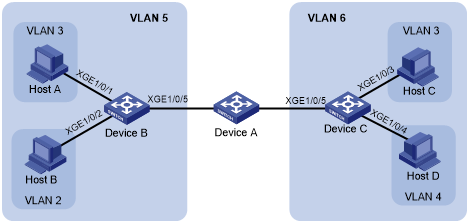Promiscuous port configuration example
Network requirements
As shown in Figure 48, configure the private VLAN feature to meet the following requirements:
On Device B, VLAN 5 is a primary VLAN that is associated with secondary VLANs 2 and 3. Ten-GigabitEthernet 1/0/5 is in VLAN 5. Ten-GigabitEthernet 1/0/2 is in VLAN 2. Ten-GigabitEthernet 1/0/1 is in VLAN 3.
On Device C, VLAN 6 is a primary VLAN that is associated with secondary VLANs 3 and 4. Ten-GigabitEthernet 1/0/5 is in VLAN 6. Ten-GigabitEthernet 1/0/3 is in VLAN 3. Ten-GigabitEthernet 1/0/4 is in VLAN 4.
Device A is aware of only VLAN 5 on Device B and VLAN 6 on Device C.
Figure 48: Network diagram
Configuration procedure
This example describes the configurations on Device B and Device C.
Configure Device B:
# Configure VLAN 5 as a primary VLAN.
<DeviceB> system-view [DeviceB] vlan 5 [DeviceB-vlan5] private-vlan primary [DeviceB-vlan5] quit
# Create VLANs 2 and 3.
[DeviceB] vlan 2 to 3
# Configure the uplink port Ten-GigabitEthernet 1/0/5 as a promiscuous port of VLAN 5.
[DeviceB] interface ten-gigabitethernet 1/0/5 [DeviceB-Ten-GigabitEthernet1/0/5] port private-vlan 5 promiscuous [DeviceB-Ten-GigabitEthernet1/0/5] quit
# Assign the downlink port Ten-GigabitEthernet 1/0/1 to VLAN 3, and configure the port as a host port.
[DeviceB] interface ten-gigabitethernet 1/0/1 [DeviceB-Ten-GigabitEthernet1/0/1] port access vlan 3 [DeviceB-Ten-GigabitEthernet1/0/1] port private-vlan host [DeviceB-Ten-GigabitEthernet1/0/1] quit
# Assign the downlink port Ten-GigabitEthernet 1/0/2 to VLAN 2, and configure the port as a host port.
[DeviceB] interface ten-gigabitethernet 1/0/2 [DeviceB-Ten-GigabitEthernet1/0/2] port access vlan 2 [DeviceB-Ten-GigabitEthernet1/0/2] port private-vlan host [DeviceB-Ten-GigabitEthernet1/0/2] quit
# Associate the secondary VLANs 2 and 3 with the primary VLAN 5.
[DeviceB] vlan 5 [DeviceB-vlan5] private-vlan secondary 2 to 3 [DeviceB-vlan5] quit
Configure Device C:
# Configure VLAN 6 as a primary VLAN.
<DeviceC> system-view [DeviceC] vlan 6 [DeviceC–vlan6] private-vlan primary [DeviceC–vlan6] quit
# Create VLANs 3 and 4.
[DeviceC] vlan 3 to 4
# Configure the uplink port Ten-GigabitEthernet 1/0/5 as a promiscuous port of VLAN 6.
[DeviceC] interface ten-gigabitethernet 1/0/5 [DeviceC-Ten-GigabitEthernet1/0/5] port private-vlan 6 promiscuous [DeviceC-Ten-GigabitEthernet1/0/5] quit
# Assign the downlink port Ten-GigabitEthernet 1/0/3 to VLAN 3, and configure the port as a host port.
[DeviceC] interface ten-gigabitethernet 1/0/3 [DeviceC-Ten-GigabitEthernet1/0/3] port access vlan 3 [DeviceC-Ten-GigabitEthernet1/0/3] port private-vlan host [DeviceC-Ten-GigabitEthernet1/0/3] quit
# Assign the downlink port Ten-GigabitEthernet 1/0/4 to VLAN 4, and configure the port as a host port.
[DeviceC] interface ten-gigabitethernet 1/0/4 [DeviceC-Ten-GigabitEthernet1/0/4] port access vlan 4 [DeviceC-Ten-GigabitEthernet1/0/4] port private-vlan host [DeviceC-Ten-GigabitEthernet1/0/4] quit
# Associate the secondary VLANs 3 and 4 with the primary VLAN 6.
[DeviceC] vlan 6 [DeviceC-vlan6] private-vlan secondary 3 to 4 [DeviceC-vlan6] quit
Verifying the configuration
# Display the private VLAN configuration on the devices, for example, on Device B.
[DeviceB] display private-vlan
Primary VLAN ID: 5
Secondary VLAN ID: 2-3
VLAN ID: 5
VLAN type: Static
Private VLAN type: Primary
Route interface: Not configured
Description: VLAN 0005
Name: VLAN 0005
Tagged ports: None
Untagged ports:
Ten-GigabitEthernet1/0/1 Ten-GigabitEthernet1/0/2 Ten-GigabitEthernet1/0/5
VLAN ID: 2
VLAN type: Static
Private VLAN type: Secondary
Route interface: Not configured
Description: VLAN 0002
Name: VLAN 0002
Tagged ports: None
Untagged ports:
Ten-GigabitEthernet1/0/2 Ten-GigabitEthernet1/0/5
VLAN ID: 3
VLAN type: Static
Private VLAN type: Secondary
Route interface: Not configured
Description: VLAN 0003
Name: VLAN 0003
Tagged Ports: None
Untagged Ports:
Ten-GigabitEthernet1/0/1 Ten-GigabitEthernet1/0/5
The output shows that:
The promiscuous port Ten-GigabitEthernet 1/0/5 is an untagged member of primary VLAN 5 and secondary VLANs 2 and 3.
The host port Ten-GigabitEthernet 1/0/2 is an untagged member of primary VLAN 5 and secondary VLAN 2.
The host port Ten-GigabitEthernet 1/0/1 is an untagged member of primary VLAN 5 and secondary VLAN 3.
